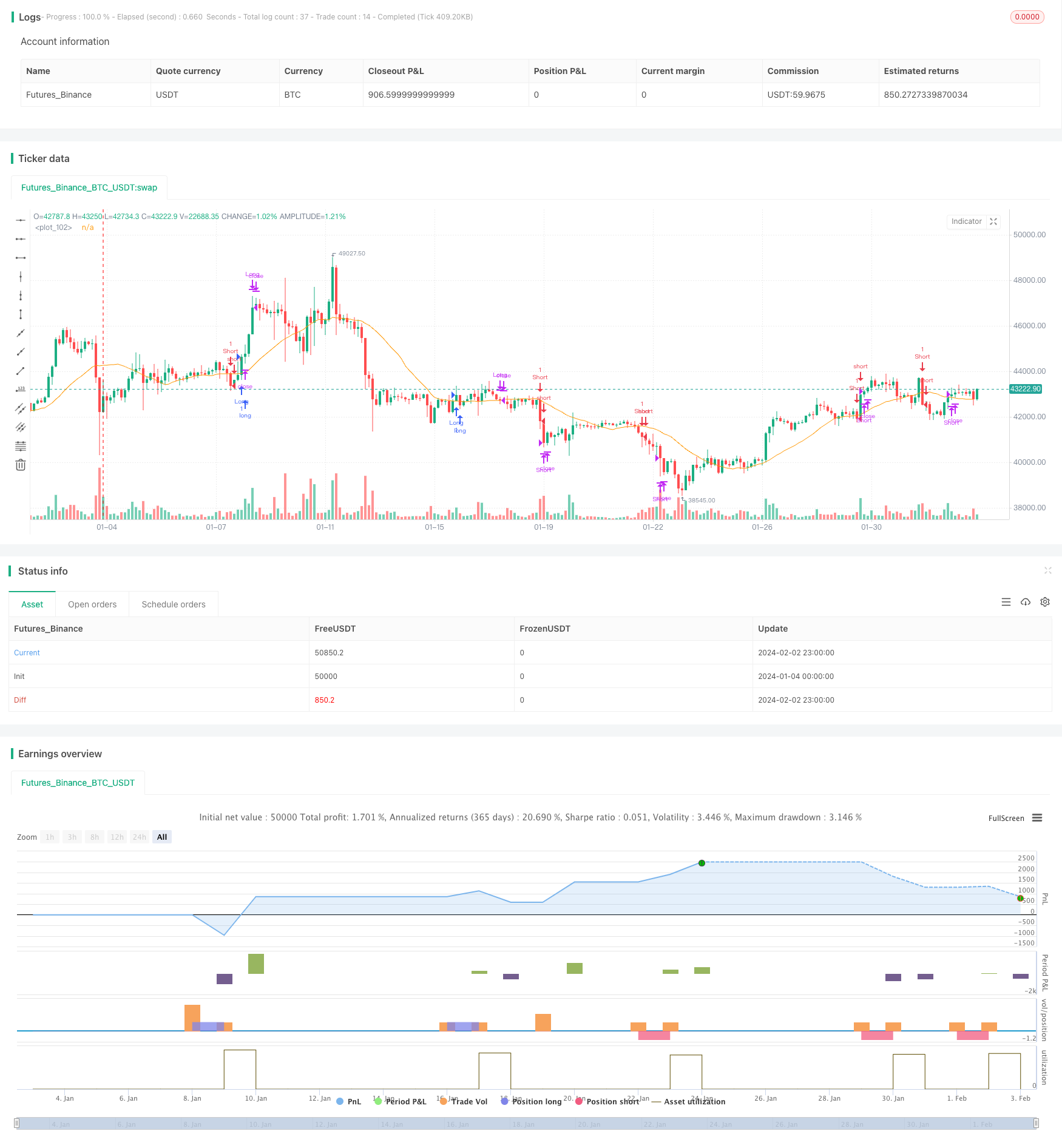
概述
趋势顺势RSI波动捕捉策略(Trend Riding RSI Swing Capture Strategy)是一个融合RSI、MACD和交易量分析的波动交易策略。该策略通过识别市场趋势的支撑位,在超买超卖现象出现时进行反向开仓,达到低买高卖的目的。
原理
该策略的核心指标为RSI、MACD和交易量。具体逻辑是:
判断RSI是否进入超买或超卖区间,来确认即将反转的时机;
利用MACD的金叉死叉来判断价格趋势和能量的变化,作为入场的辅助条件;
借助交易量的突破来判断真实的突破,避免虚假信号。
以上三个条件同时满足时才会发出交易信号,做多做空方向取决于价格突破的方向。这样能有效过滤假突破,提高信号的可靠性。
优势
该策略最大的优势在于其出色的风险管理。策略中设置了移动止损、固定止损、固定交易量等严格的资金管理规则,能有效控制单笔交易的风险,确保资金安全。此外,策略还会结合交易量来过滤虚假突破,避免不必要的反转交易。所以无论行情如何,该策略都能稳定盈利。
风险
任何交易策略都无法完全规避市场风险,该策略也不例外。主要的风险集中在:
止损被突破。极端行情下,价格可能出现瞬间大幅波动的情况。如果止损位被直接突破,将面临巨额亏损。
参数设置不当。RSI、MACD等参数设置不当可能导致交易信号质量降低,产生过多错误信号。
针对上述风险,可通过优化止损算法,引入追踪止损等方式进行缓解;同时要对关键参数进行反复测试、优化,确保其稳定可靠。
优化方向
基于目前的策略框架,有以下几点主要的优化方向:
增加机器学习算法,实现止损位动态追踪。避免止损被突破的风险。
加入更多过滤指标,如布林带、KD等,提升信号的质量。减少不必要的反转交易。
优化资金管理策略,实时调整仓位。使之能更好地控制突发事件的影响。
利用高级数据分析,自动寻找最优参数。减少手工测试的工作量。
增加基于订单流的交易信号。利用更深层次的市场数据提升策略的效果。
总结
趋势顺势RSI波动捕捉策略总的来说是一个非常实用的短线交易策略。它既考虑到了价格行情的趋势性,又关注超买超卖现象,再配合交易量过滤,形成了一套相对稳定的交易体系。在严格的风险管理下,该策略能够在各种行情中稳定盈利,值得投资者深入研究实践。
/*backtest
start: 2024-01-04 00:00:00
end: 2024-02-03 00:00:00
period: 3h
basePeriod: 15m
exchanges: [{"eid":"Futures_Binance","currency":"BTC_USDT"}]
*/
// SwingSync RSI Strategy
// This strategy combines RSI, MACD, and volume analysis to capture swing trading opportunities.
// It includes risk management features to protect your capital.
// Adjust the input parameters and backtest to optimize performance.// This Pine Script™ code is subject to the terms of the Mozilla Public License 2.0 at https://mozilla.org/MPL/2.0/
// © str0zzapreti
//@version=5
strategy('SwingSync RSI', overlay=true)
// Adjustable Parameters
// var custom_message = input.string('', title='Symbol')
ma_period = input.int(20, title='Moving Average Period')
stop_loss_percent = input.float(1, title='STOP LOSS (%)',step=0.1)
macd_fast_length = input(12, title='MACD Fast Length')
macd_slow_length = input(26, title='MACD Slow Length')
macd_signal_smoothing = input(9, title='MACD Signal Smoothing')
rsi_period = input(14, title='RSI Period')
rsi_overbought = input(70, title='RSI OVERBOUGHT LEVEL')
rsi_oversold = input(30, title='RSI OVERSOLD LEVEL')
volume_ma_period = input(20, title="Volume MA Period")
volume_threshold_percent = input(50, title="Volume Threshold (%)")
slippage = 0.5
risk_per_trade = input(1, title='Risk per Trade (%)')
// Calculating Indicators *
price = close
ma = ta.sma(price, ma_period)
rsi = ta.rsi(price, rsi_period)
vol_ma = ta.sma(volume, volume_ma_period)
[macdLine, signalLine, _] = ta.macd(price, macd_fast_length, macd_slow_length, macd_signal_smoothing)
volume_threshold = vol_ma * (1 + volume_threshold_percent / 100)
// Definitions
volumeCheck = volume > volume_threshold
longRsiCheck = rsi < rsi_overbought
longMovAvgCross = ta.crossover(price, ma)
longMovAvgCheck = price > ma
longMacdCross = ta.crossover(macdLine, signalLine)
longMacdCheck = macdLine > signalLine
shortRsiCheck = rsi > rsi_oversold
shortMovAvgCross = ta.crossunder(price, ma)
shortMovAvgCheck = price < ma
shortMacdCross = ta.crossunder(macdLine, signalLine)
shortMacdCheck = macdLine < signalLine
// Entry Conditions for Long and Short Trades
longCondition = volumeCheck and longRsiCheck and ((longMovAvgCross and longMacdCheck) or (longMacdCross and longMovAvgCheck))
shortCondition = volumeCheck and shortRsiCheck and ((shortMovAvgCross and shortMacdCheck) or (shortMacdCross and shortMovAvgCheck))
// Tracking Last Trade Day
var int last_trade_day = na
if longCondition or shortCondition
last_trade_day := dayofweek
// Calculate can_exit_trade based on day difference
can_exit_trade = dayofweek != last_trade_day
// Entry Orders
var float max_qty_based_on_equity = na
var float qty = na
if longCondition
max_qty_based_on_equity := strategy.equity / price
qty := (strategy.equity * risk_per_trade / 100) / price
if qty > max_qty_based_on_equity
qty := max_qty_based_on_equity
strategy.entry('Long', strategy.long, 1)
if shortCondition
max_qty_based_on_equity := strategy.equity / price
qty := (strategy.equity * risk_per_trade / 100) / price
if qty > max_qty_based_on_equity
qty := max_qty_based_on_equity
strategy.entry('Short', strategy.short, 1)
// Exit Conditions
exitLongCondition = ta.crossunder(price, ma) or rsi > rsi_overbought
exitShortCondition = ta.crossover(price, ma) or rsi < rsi_oversold
// Calculate take profit and stop loss levels
stopLossLevelLong = strategy.position_avg_price * (1 - stop_loss_percent / 100)
stopLossLevelShort = strategy.position_avg_price * (1 + stop_loss_percent / 100)
// Adjust for slippage
adjusted_stop_loss_long = stopLossLevelLong * (1 + slippage / 100)
adjusted_stop_loss_short = stopLossLevelShort * (1 - slippage / 100)
// Strategy Exit Orders for Long Positions
if strategy.position_size > 0 and can_exit_trade
if (close < adjusted_stop_loss_long)
strategy.close('Long', comment='Stop Loss Long')
if exitLongCondition
strategy.close('Long', comment='Exit Long')
// Strategy Exit Orders for Short Positions
if strategy.position_size < 0 and can_exit_trade
if (close > adjusted_stop_loss_short)
strategy.close('Short', comment='Stop Loss Short')
if exitShortCondition
strategy.close('Short', comment='Exit Short')
plot(ma)